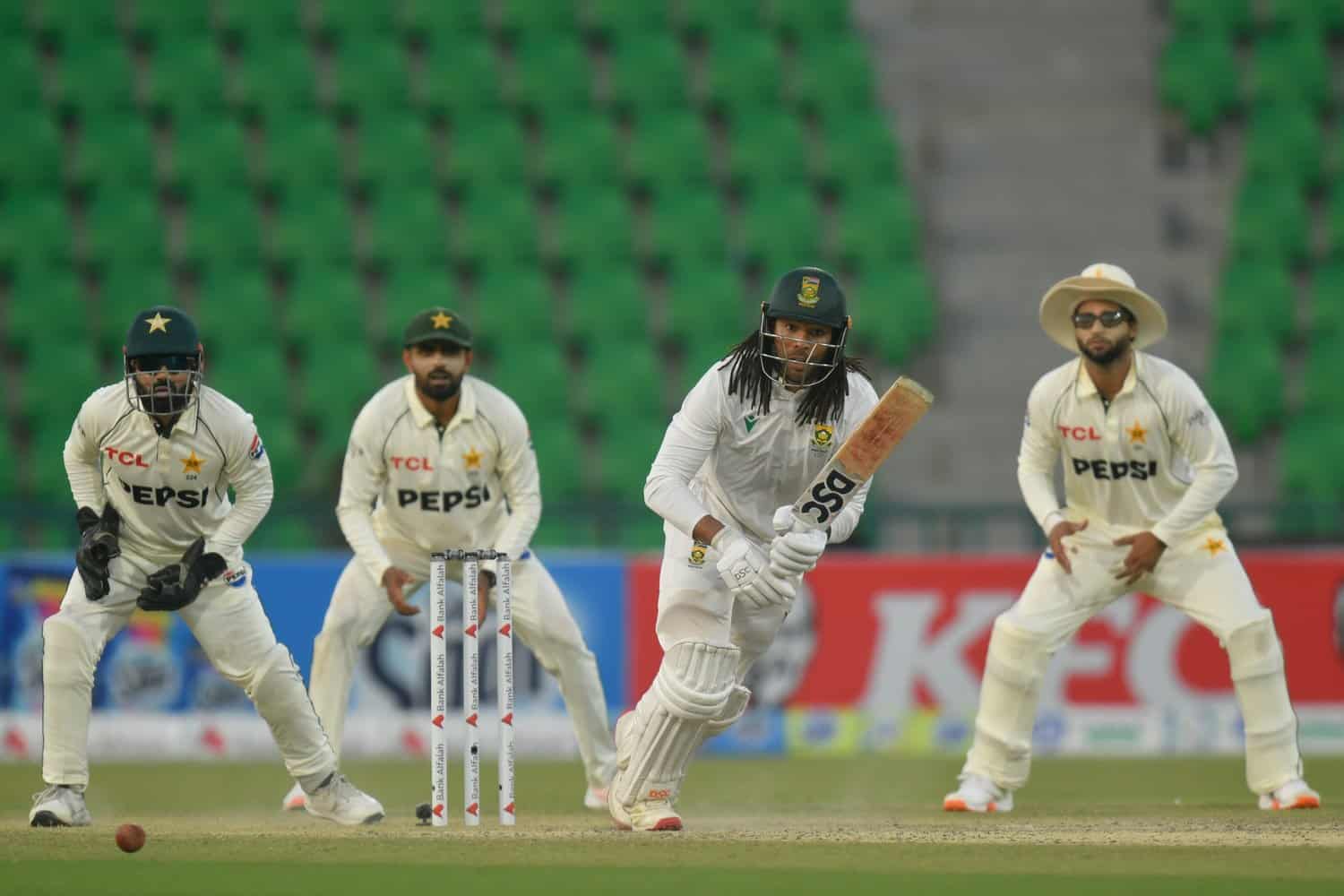In Lahore the Pakistan vs South Africa Test Series 2025 opened in the kind of crucible that strips cricket to its essentials, patience, precision and nerve. A dry, cracked surface at the Gaddafi Stadium has already revealed its secrets, and on the first two days those truths have rewarded craft and punished lapses, leaving Pakistan marginally ahead while South Africa cling to a foothold built on resolve.
Day one swings set the tone
Pakistan’s first day was a lesson in tempo control. After Kagiso Rabada trapped Abdullah Shafique lbw with the third ball, Imam-ul-Haq and Shan Masood stitched 161 for the second wicket to pull the hosts into calm waters at 163 for 1. Imam reached 93 and Masood 76, their innings framed by disciplined strokeplay and a willingness to wait for the bowlers to err.
South Africa’s spinners did find a window, Prenelan Subrayen pinned Masood before tea and Senuran Muthusamy struck twice in two balls to remove Imam and Saud Shakeel, turning 199 for 2 into 199 for 4 in a blink. Yet Mohammad Rizwan and Salman Agha then rebuilt with an unbeaten 114 for the sixth wicket to close 313 for 5, a partnership built on trust, one that hinted at the value of occupying the crease on this spin friendly track.
Muthusamy’s morning and a Pakistani collapse
Day two belonged to Senuran Muthusamy, and by stumps his fingerprints were everywhere. Pakistan advanced to 362 for 5, then Muthusamy produced a career-best 6 for 117, including two separate bursts of two wickets in two balls and three in four, to scythe through the lower order and limit the hosts to 378 all out. The final five wickets fell for just 16, a collapse that changed the calculus of a match trending toward 400 plus.
Muthusamy’s honest assessment captured both the challenge and the opportunity.
“It’s probably as spin-friendly as I’ve ever played in,” he said, calling it “a chance to open up the game” for his side.
The heartbeat of Pakistan’s innings
Before the fall, Rizwan and Agha had embodied clarity. Rizwan counter-attacked to 75, two fours and two sixes punctuating his calculated risk, before Muthusamy finally kissed the outside edge and Kyle Verreynne did the rest. Salman Agha, who resumed on 52, showed mature judgment to reach 93 with five fours and three sixes, only to seek a fourth six and find long on off Subrayen, the catch neatly pouched by Muthusamy to complete a sequence that felt both ruthless and poetic.
In the margins were moments that could have shifted the day one ledger, a drop at mid off for Imam, another at short leg off Masood, and a chance spilled off Agha. Pakistan cashed those reprieves, then South Africa responded, a tug of war that defined a first innings of 378 that felt hard earned on a surface offering generous turn and increasingly variable bounce.
De Zorzi stands tall as South Africa wobble
South Africa’s reply mirrored the match’s rhythm, moments of composure bracketed by sharp turns. Aiden Markram and Wiaan Mulder departed after promising starts, both edging Noman Ali with Verreynne steady behind the stumps for Pakistan. That brought Tony de Zorzi to Ryan Rickelton, and together they built a 94-run stand that looked every bit a blueprint for survival and scoring in Lahore.
Rickelton, 71 off 137, glided through gaps with nine fours and two lofted slog sweeps against Noman. Then the door creaked. Rickelton edged the part-time off spin of Salman Agha to Babar Azam at slip, and in a hurry the innings lost four wickets for 26 runs to slump to 200 for 6. Through it all de Zorzi was unflustered, 81 not out off 140 by stumps, combining crisp drives with deft sweeps and one audacious slog sweep for six against the spin, a player growing in the glare and giving the Proteas a lifeline.
Technique, temperament and a turning pitch
De Zorzi survived early edges through the cordon off Hasan Ali and an lbw decision against Sajid Khan that was overturned with the ball pitching just outside leg. Those brushes with fate did not rattle him, they refined him. From there he settled into his method, using the sweep to distort lines and rotating strike to prevent Pakistan from locking into a single plan.
For Pakistan, Noman Ali’s figures told a tale of accuracy and persistence. His pressure spells set the trap for a late slide, and with Sajid Khan prising out Dewald Brevis first ball and Salman Agha’s off spin claiming Rickelton, the hosts reaffirmed a key truth of subcontinental Tests, in these conditions bowlers hunt in packs. The control of Noman, the subtle changes of pace from Subrayen earlier, and the hands of Rizwan behind the stumps created a sequence that felt inevitable once it began, a cluster typical of dry, turning pitches.
What the captains and spinners read in Lahore
Simon Harmer, who probed tirelessly for 28 overs on day one, was frank about the significance of the coin and the character of the surface.
“In the subcontinent the toss plays a big part. The best batting conditions are usually in the first session, or on day one. They got the luck of the draw with the toss and they maximised that well.”
He added a practical forecast that has already borne out.
“The odd ball is turning, but if anything I think it will get lower, because the ball sort of deteriorates quickly as well.”
Those words tracked with the evidence. Even on day one several deliveries scooted and some leapt, and by day two, with footmarks growing and the seam fraying, the pitch had sharpened its teeth. In this theatre of attrition, every batter’s first 30 balls felt like a trial and every bowler’s spell demanded unwavering discipline.
Selection, strategy and the Proteas gamble on spin
South Africa came armed with a plan that matched the conditions. They backed three spinners, Harmer, Muthusamy and Subrayen, with Rabada the lone specialist quick, while Wiaan Mulder offered seam support. The choice to omit Marco Jansen, and to bring in Dewald Brevis, a renowned player of spin, spoke to a strategy built on variety and batting flexibility.
For much of day one the execution was steady rather than suffocating, then Muthusamy found his seam and rhythm on day two, gathering drift and dip and hitting that ideal length that made strokeplay feel like a negotiation. His 6 for 117 was not just a set of figures, it was a statement that South Africa’s spin investment had teeth, and it kept the World Test Championship holders alive in a contest that could have slipped away before lunch.
Pakistan’s patience and the power of partnerships
On the home side, the template was clear and effective. Imam-ul-Haq and Shan Masood absorbed pressure and wore down bowlers in the heat, a blueprint for others to follow. Later, Rizwan and Agha took the baton and ran with it, their sixth wicket stand of 163 on day two expanding the cushion and forcing South Africa into defensive fields that opened singles and then boundaries, a familiar pattern in Asia when the ball is old and grip is unpredictable.
Each partnership also had a human edge. Imam’s reprieve after fifty, Masood’s second chance via a tough short leg miss, Agha’s let-offs late on day one, these moments carried the emotional swing of a series opener. Pakistan turned most of them into runs, and in matches where 40 or 50 can be worth 80 on truer surfaces, that conversion counts double.
The Proteas mindset for day three
From the visitors came a clear message after a stinging finish to day two.
“It’s not ideal to have lost those wickets so close to the end of play,” Muthusamy admitted. “But this does happen in Test cricket, so it’s about bouncing back and finding some resilience again.”
They will resume on 216 for 6, de Zorzi on 81 and Muthusamy on 6, the deficit 162. The equation is unforgiving, but not impossible. Bat through the first hour, reduce the arrears into double figures, and nudge the game into a space where their spinners can attack with a semi-par score behind them. In Lahore, as the surface continues to tire, sessions can be won by discipline as much as by flair.
Why this opening matters in the World Test Championship
This is the start South Africa expected, a searching examination away from home while defending their World Test Championship crown. The tour of Pakistan begins a run of Asian challenges, with India next month and Sri Lanka in early 2027, and the lessons here will travel. How to balance tempo, how to trust the sweep and the forward press, how to share spin workloads without letting the game drift, these are habits that can anchor a title defense across continents.
The footholds are visible, Muthusamy’s six-for, Rickelton’s assurance at the top, de Zorzi’s poise under pressure. If the Proteas turn those threads into a sustained fight on day three, this match could become a touchstone for their subcontinental learning curve, the kind that shapes a campaign rather than just a week. For Pakistan, the opportunity is to press home their advantage with the ball, keep the lead meaningful, and then trust their batters to navigate a surface that will ask new questions in the fourth innings, a phase where clarity can trump talent.
Key numbers from Lahore
- Pakistan 378 all out after resuming 313 for 5,
- Senuran Muthusamy 6 for 117, including two double-strike bursts,
- Rizwan 75 and Salman Agha 93 in a sixth wicket stand worth 163,
- South Africa 216 for 6 at stumps on day two, trail by 162,
- Tony de Zorzi 81 not out with nine fours and one six.
The human stories inside the numbers
There is something fitting about Muthusamy, a bowler who has often plied his trade on seamer-friendly pitches at home, finding his best in a place where the game slows to a chess match. He talked about toil and team effort, and his spell reflected exactly that, an understanding that on turning tracks the build-up is as vital as the payoff. Pakistan’s response came from batters who understood their roles too, Rizwan’s counter and Agha’s calm showing the power of complementary gears.
And then there is de Zorzi. Every tour has a batter who becomes the hinge, the player whose innings either anchors a comeback or stands as a noble failure. His is unfinished, and that is South Africa’s hope. Finish it well, shepherd the tail, and the match shifts feel by feel, over by over, toward parity. Fail, and Pakistan’s spinners, buoyed by scoreboard pressure and a surface that rewards patience, will sense the moment to strike.
What to watch next
The first hour on day three is the lens through which the rest of this Test will be viewed. Pakistan will tempt de Zorzi into the aerial sweep, probe Muthusamy’s defense, and look to Noman Ali to exploit the footmarks. South Africa will seek to thread singles, resist the release shot, and ride the uneven bounce long enough to turn 216 for 6 into something the dressing room can rally around.
If the visitors clear that hurdle, their three-pronged spin attack can re-enter with purpose and scoreboard support. If Pakistan end the innings quickly, they will own the pace of the match. Either way, Lahore has already given us a gripping opening, one that feels exactly like a proper subcontinental Test, early mastery for the hosts, hard lessons for the travellers, and just enough room for character to redefine the script.






